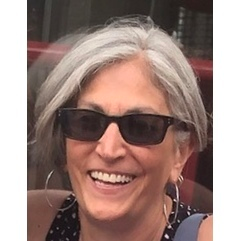In this RootsCamp panel on the Indivisible movement, Micah Sifry, a longtime progressive writer and organizer who is also a co-founder of an Indivisible group in New York congressional District 16, talks with Aram Fischer, the co-founder and facilitator of Indivisible Middle Tier and a leader of Indivisible San Francisco; Paula Martinos-Mantay, the co-founder of Statewide Indivisible Michigan (SWIM); and Lara Putnam, an historian who analyzes grassroots political organizing in the post-2016 period. They discuss how Indivisible started, the tensions they navigated between movement and organizational imperatives, the role of information flow and transparency, and the relationship between local and national leaders.
This conversation has been edited and condensed for brevity and readability. You can read the entire conversation here.
Micah Sifry: Indivisible started with a Google Doc. Right after President Trump was elected, a group of progressive congressional staffers started co-writing a guide that they thought might be useful to people figuring out how to respond to Trump. They were drawing on the lessons from the Tea Party Movement. How the Tea Party organized locally, focused on Congress, and managed in many cases to block or at least slow down the Obama agenda.
They put that Google Doc up online for free. It had millions of downloads once the media started drawing attention to it. And it was done in this spirit of, “Here’s what we know; you use it if it makes sense to you.” So that was the original spirit of Indivisible. Things got more complicated once an organization got created.
Critically, there was also a map. In the early days, you could go to this page and look up your zip code. And if you didn’t see something or if you wanted to add something to the map, you could just put your own group onto the map. I think somewhere close to 6,000 groups were posted. There is no question that this channeled a huge number of people into meaningful local groups, and many of those groups continue today.
Paula Martinos-Mantay: I discovered Indivisible in early 2017 because I was so horrified by the election results and determined to resist the Trump agenda. I’ve never really been politically engaged other than voting. My local Indivisible group started meeting in living rooms twice a month. Within about six months, I found myself joining the leadership team of my local group.
None of us knew what we were doing. We were learning pretty fast what it meant to be a grassroots resistance group. My group decided to work on voter registration and flipping seats in our Michigan State House and in our Senate.
Through the end of 2018, we really didn’t have a lot of guidance in the field from Indivisible National. Certainly, we had national directives and meetings and lots of emails with guidance, but there was not a strong presence with field organizers in Michigan. We ran through a series of hired regional field organizers. None lasted very long, and they honestly didn’t make a great attempt to form relationships with us. They never reached out to us.
We asked, probably over the course of a good year, year-and-a-half, for Indivisible.org to share lists of local groups and leaders in Michigan, something beyond that map, because the map didn’t always seem to be the most accurate source of data. Occasionally, they would comply and send us a list, but they were usually out of date and largely inaccurate. By the end of 2018, Indivisible told us that they no longer would be sharing lists or data with us. We also didn’t have a sense that we were getting new members funneled our way from national online marketing efforts.
We felt like we were being kept in a silo and not able to network. And we knew we could create tremendous power if we were united. So, in January of 2019, Michelle Pallas and I took on a task to create a statewide Indivisible coalition. It was at that time I met Aram Fischer and joined his Middle Tier Slack group, a nationwide group of hundreds of Indivisible leaders. That was an absolute game changer for us. Now we had some support, a place to go to for questions, best practices, and advice.
On June 1, 2019, we convened our first gathering of more than seventy Indivisible leaders from the state of Michigan. SWIM or Statewide Indivisible Michigan was born. SWIM leaders decided the best use of our resources would be to flip our Michigan State House in 2020 and then our Senate in 2022.

Aram Fischer: I absolutely adore Indivisible. This movement has offered me so much. It’s where I learned to be an organizer.
I’ve been a lifelong activist. I come from a long line of activist Jewish women, going back to my great grandmother, who I’m named after. And when Trump won, I knew, whatever I’d been doing as an activist, I had to go from that to more. Indivisible is where I found that home to do more. I thought that I should stop complaining about all the tech folks that were ruining my city, which is what we do in the Bay Area, and I should actually lead the tech group so I can harness their incredible talent on behalf of the movement.
And we grew really, really quickly — crazy hockey stick growth. Our sixth meeting, we sat two sessions of 225 people; we had 1,000 people on our waiting list that day. And we had sixty-to-seventy leaders, whatever that meant at that point, who were trying to figure out what the hell to do with that. You know, what do you do with 1,400 people who want to hear from you and follow your leadership when you’re trying to follow someone else’s?
And we figured it out.
I found an incredible crew of five other people, and we formed something called Indivisible Data. We ended up creating a Twitter bot that would basically blast out shareable healthcare graphics, and an individual graphic for each congressional district in the country, and it intentionally added the local Indivisible group that we had identified as someone that might want to share it out further.
We were just do-gooders; we had no idea what would happen. And next thing you know, someone from Invisible NY-19 used one of our graphics of an empty chair at a town hall that Rep. Sean Patrick Maloney was holding for John Fossa because he wouldn’t talk to his constituents. And that made it to the Rachel Maddow show.
Right around then, the fight over repealing ACA was happening, and I read an article that said that the last three votes were from Illinois. I was livid. I had two back surgeries covered by Obamacare. So I got in touch with a guy from Indivisible Skokie, a place I’ve never been. And he connected me to the leadership of Indivisible Illinois, and together we did the Illinois Health Care Truth Tour — a digital billboard truck that drove around from event to event in Illinois, spreading the word. We put graphics from Invisible Data on the side of it, showing the local impact of repeal in all these Republican districts.
And again, I said, “Oh my God, we need to talk to each other more.” The most important lesson for me is this: the flow of information is the lifeblood of movements. When you let information flow across these networks and you help them connect and go from node to node, amazing things can happen because there’s phenomenal talents across any movement.
I founded something called the Indivisible Middle Tier. The basic idea was to create a space that was in between the national tier and the local tier that helps information flow in both directions. There’s about six hundred or so leaders who are more or less active, statewide leaders and local leaders as well as all kinds of people who have created verticals like the secure elections network; it’s where we go to collaborate, commiserate, and share stories.
Lara Putnam: The stories that we’ve already heard turn out to be really typical of experiences across the country. I’ll make a few points about that broader context. The first is that the surge of grassroots group formation in the wake of Donald Trump’s election actually didn’t begin with the Indivisible guide. In any number of places people came together with people with whom they had some prior political connection. For example, the Women’s March. In a case in the suburbs north of Pittsburgh, women who were just swim team moms, came together to charter a bus to go to DC for the Women’s March, and afterwards they formed a group they called, the Women of Bus One, and they have since remade politics in their township. They ended up running candidates and flipping the town council.
That’s the other piece that we’ve seen again and again as these new grassroots groups were formed in the wake of Donald Trump’s election, even though the guidance they were receiving from the different national conveners — whether that was the Women’s March or Indivisible — tended to be very much focused on national events and national interlocutors.
What I’m left with is the immense potential for impact of making it possible for people to find each other for collective action. So many things grew outward from the original information in the Indivisible guide and the map, and the things that people created around them, like Indivisible Middle Tier. Providing that kind of infrastructure for decentralized group formation turns out to be super impactful.
That use of digital infrastructure really stands in contrast to other trends we’ve seen recently. We also have seen the use of digital outreach for a kind of Uber-ization of political volunteering, which channels people into very light touch activities, like text banking, phone banking, or postcarding, in ways that are more atomizing. That’s not about pulling people together, sharing information and seeing what they can generate together — which is what Aram and Paula have been talking about — but rather is about harvesting the available labor from an increasingly digital space, a world in which you can make use of very small amounts of commitment from many people without ever introducing them to each other. And the payoff of that is much more questionable, certainly in terms of building long-term power. So those are the sort of split lessons that I see before us.




